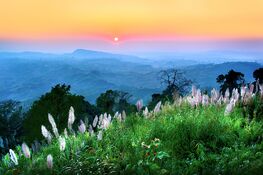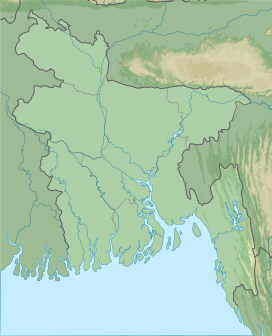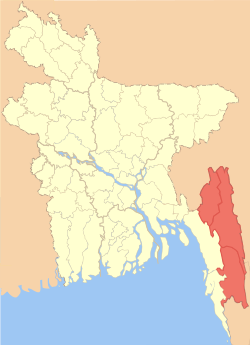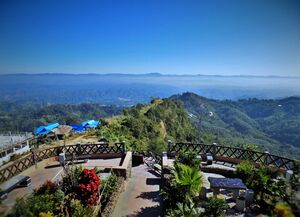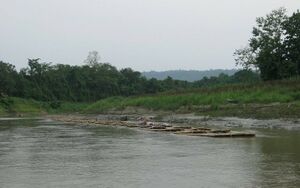زمام تلال تشيتاجونج
| زمام تلال چيتاگونگ Chattogram Hill Tracts | |
|---|---|
Sajek Valley Rangamati | |
| أعلى نقطة | |
| الإحداثيات | 22°33′00″N 92°17′00″E / 22.55000°N 92.28333°E |
| الجغرافيا | |
| الموقع | Khagrachari District, Rangamati Hill District, and Bandarban District, Bangladesh |
زمام تلال چيتاگونگ/تشيتاجونج ( Chattogram Hill Tracts ؛ بالبنغالية: পার্বত্য চট্টগ্রাম)، والتي كثيراً ما تُقصَر إلى زمام التلال Hill Tracts وتُختصر إلى CHT، هي مجموعة من الأضلع في قسم چيتاگونگ في جنوب شرق بنگلادش، تحد الهند و ميانمار (Burma) in the east. Covering 13,295 square kilometres (5,133 sq mi), they formed a single district until 1984, when they were divided into three districts: Khagrachhari, Rangamati, and Bandarban.
Topographically, the Hill Tracts are the only extensively hilly area in Bangladesh. It was historically settled by many tribal refugees from Burma Arakan in the 16th century and now it is settled by the Jumma people. Today, it remains one of the least developed parts of Bangladesh.[1]
The Chattogram Hill Tracts along with Sikkim, Tawang, Darjeeling, Bhutan, and سريلانكا, constitute some of the remaining abodes of Buddhism in South Asia.
الجغرافيا
The Chittagong Hill Tracts (CHT), the only extensive hilly area in Bangladesh, lie in the southeastern part of the country (210 25' N to 230 45' N latitude and 910 54' E to 920 50' E longitude) bordering Myanmar on the southeast, the Indian state of Tripura on the north, Mizoram on the east and Chittagong district on the west. The area of the Chittagong Hill Tracts is about 13, 184 km2, which is approximately one-tenth of the total area of Bangladesh. The Chittagong Hill Tracts combine three hilly districts of Bangladesh: Rangamati, Khagrachhari and Bandarban districts.[2]
The mountainous rugged terrain with deep forests, lakes and falls gives it a different character from the rest of Bangladesh.
السكان
According to the census of 1991, the population was 974,447, of whom 501,114 were tribal people and the rest were from the Bengali (Muslim and Hindu) community.[3] The tribal populations include the Chakma, Marma, Tripura, Tanchangya, Assamese, Keot (Kaibarta), Chak, Pankho, Mro, Murang, Bom, Lushei, Khyang, and Khumi,[4] and differ markedly from the Bengali majority of Bangladesh in language, ethnicity and religion.[5]
The population of the three districts (zilas) totalled 1,842,815 in the returns of the census of 2022, making the population density roughly 120 per km2. Tribes are mainly followers of Buddhism (41.74%). The percentages of Muslims are: Bandarban 52.68%, Khagrachari 46.56% and Rangamati 36.22%. Most of the Christian population is in Bandarban.[6][7][8]
Religion in the Chittagong Hill Tracts (2022)
التاريخ
It was the warzone between the Arakan Kingdom,Chakma kingdom and the Twipra Kingdom.
In the early 15th century the Chakma people came from Arakan (Burma) due to repression and hostility by Rakhaine people. The Chakma are the single largest tribe, comprising half of the tribal population. The Marma people are the second largest tribe. They came from Burma when Arakan was conquered by Burmese king Bodawpaya. The Place was ruled by the Chakma king their was a conflict between the Chakma king and Mughals in which the Chakma king agreed to pay tribute of cotton to the Mughals
Mughal and early British records name the region Jum Bungoo, Jum mahal or Kapas mahal.[9][10] In 1787, the East India Company made the region its tributary after battling tribal leaders.
Under British control, the British East India Company in order to supress the Chakma queen power Kalindi Rani divided the hills into three parts.This was done in regional areas known as Chakma Circle, Mong Circle, and Bohmong Circle. The early colonial history of the Chittagong Hill Tracts is a record of recurring raids by the eastern hill tribes (Mizo or Lushai) and of the operations undertaken by the British to repress them.
الحكم البريطاني
The use of the name Chittagong for this area dates to the 1860 British annexation of the region, bringing it under the direct control of British India. Situated beyond the inland hills, Chittagong proper is a coastal area in the plains where the British were based. As colonial influence grew, "Chittagong" enlarged as well, expanding eastwards[11] to subsume the Hill Tracts under its revenue-collection territory.[10]
The recorded population increased from 69,607 in 1872 to 101,597 in 1881, to 107,286 in 1891, and to 124,762 in 1901. The census of 1872 was, however, very imperfect, and the actual population growth probably did not exceed what might be expected in a sparsely inhabited but fairly healthy tract.[12]
When the 1901 census was taken there were no towns, and 211 of the villages had populations of less than 500 apiece; only one exceeded 2,000. The population density, excluding the area of uninhabited forest (1,385 square miles), was 33 persons per square mile. There was a little immigration from Chittagong, and a few persons had emigrated to Tripura. The proportion of females to every 100 males was only 90 in the district-born and 83 in the total population. Buddhists numbered 83,000, Hindus 36,000, and Muslims 5,000.[13]
نهاية الحكم البريطاني
النزاع
استخدام الأراضي والبيئة
زراعة التبغ
Tobacco cultivation is damaging the ecology of the area, with the loss of indigenous trees such as Chukrasia tabularis (Indian mahogany), and soil fertility.
Most of the farmers of Rangamati, Bandarban, and Khagrachhari have been losing their interest in cultivating their own indigenous crops after defaulting on loans provided by tobacco companies.[14]
قضايا بيئية
Like other mountainous areas in South and Southeast Asia, the Chittagong Hill Tracts are undergoing deforestation and land degradation arising from environmentally unsuitable activities such as tobacco cultivation in sloping land, shifting cultivation and logging.[15] Shifting cultivation, also known as slash-and-burn agriculture or swidden cultivation, embraces a large variety of primitive forms of agriculture. It is a unique stage in the evolution from hunting and food gathering to sedentary farming. Humankind began to change its mode of life from food gatherer to food producer about 7000 B.C. by adopting shifting cultivation. Some form of shifting cultivation has been practised in most parts of the world, but more intensive forms of agriculture have subsequently replaced it.[16]
The present shifting cultivation system with short fallow period in the Chittagong Hill Tracts has accelerated erosion, land degradation, deforestation, and impoverishment of tribal people in CHT. If the present state of degradation is continued, most of the areas under shifting cultivation will be severely degraded[17] and future generations will face more difficulties in eking out their livelihoods on further degraded land, although there is some scope for shifting cultivators to leave the degraded fields and move to other areas. It is estimated that on average eight hectares of land is necessary for the sustenance of a family in the Chittagong Hill Tracts. If this ratio is adopted, 1,240,000 ha land is required to sustain the present population; however, the total land available, excluding the reserve forest, is 928,000 ha. Shifting cultivation, therefore, cannot fulfill even the subsistence requirements of the people. In such a situation, either large non-farm employment opportunities need to be created or more productive land-use systems need to be developed and adopted. Given the sluggish growth of the economy, there is limited scope for generating adequate non-farming employment opportunities in the near future. It is, therefore, imperative to replace the present shifting cultivation system with more productive and sustainable land use systems to enable people to secure their livelihoods.[18]
ببليوجرافيا
- Bangladesh: Militarization in the Chittagong Hill Tracts. The slow demise of the region's indigenous peoples. IWGIA report 14. Copenhagen: IWGIA, Organising Committee CHT Campaign and Shimin Gaikou Centre. May 2012
- Shapan Adnan & Ranajit Dastidar."Alienation of the Lands of Indigenous Peoples of the Chittagong Hill Tracts of Bangladesh". Dhaka: Chittagong Hill Tracts Commission & IWGIA. May 2011.
- Shelly, Mizanur Rahaman. (1992). "The Chittagong Hill Tracts of Bangladesh: The Untold Story". Dhaka, Bangladesh: Centre for Development Research, Bangladesh.
- "Life is not Ours: Land and Human Rights in the Chittagong Hill Tracts", Bangladesh. Copenhagen, Denmark: Organizing Committee, Chittagong Hill Tracts Campaign, 1991.
- Brauns, Claus-Dieter, "The Mrus: Peaceful Hillfolk of Bangladesh", National Geographic Magazine, February 1973, Vol 143, No 1
المراجع
- ^ Ghanea, Nazila (2005). Minorities, Peoples and Self-Determination. Martinus Nijhoff Publishers. p. 117. ISBN 9004143017.
- ^ Ministry of Chittagong Hill Tracts Affairs http://www.mochta.gov.bd/
- ^ "Frequently asked questions". Chittagong Hill Tracts Administration, Government of Bangladesh. Archived from the original on 18 April 2008.
- ^ Life is not Ours Land and Human Rights in the Chittagong Hill Tracts, Bangladesh. Copenhagen: Chittagong hill tracts commission. 2000. pp. 4–7. OCLC 67231760.
- ^ "Indigenous peoples of the Chittagong Hill Tracts". The indigenous world – Asia. IWGIA – International work group for indigenous affairs. Retrieved 11 December 2013.
- ^ "Population & Housing Census=2011: Community Report: Bandarban" (PDF). Bangladesh Bureau of Statistics. pp. xiii, 465. Retrieved 2023-03-14.
- ^ "Population & Housing Census=2011: Community Report: Khagrachhari" (PDF). Bangladesh Bureau of Statistics. pp. xiii, 563. Retrieved 2023-03-14.
- ^ "Population & Housing Census=2011: Community Report: Rangamati" (PDF). Bangladesh Bureau of Statistics. pp. xiii, 521. Retrieved 2023-03-14.
- ^ Geiger, Danilo (2008). Frontier Encounters: Indigenous Communities and Settlers in Asia and Latin America. International Work Group for Indigenous Affairs. p. 487. ISBN 978-87-91563-15-7.
- ^ أ ب Ghanea-Hercock, Nazila; Xanthaki, Alexandra; Thornberry, Patrick (2005). Minorities, Peoples And Self-determination. Martinus Nijhoff. p. 115. ISBN 90-04-14301-7.
- ^ International Labour Office (2000). Traditional occupations of indigenous and tribal peoples. International Labour Organization. p. 73. ISBN 978-92-2-112258-6.
The Chittagong Hill Tracts is a misnomer. This was the name given to this region after its annexation [...]
- ^ "Imperial Gazetteer2 of India, Volume 10, page 319 – Imperial Gazetteer of India – Digital South Asia Library". dsal.uchicago.edu.
- ^ "Imperial Gazetteer2 of India, Volume 10, page 320 – Imperial Gazetteer of India – Digital South Asia Library". dsal.uchicago.edu.
- ^ Chakma, Shantimoy (21 May 2009). "Tobacco cultivation poses threat to environment in CHT". The Daily Star. Rangamati. Retrieved 15 April 2020.
- ^ Rasul, 2009.
- ^ Rasul and Thapa, 2003. Factors influencing shifting cultivation in South and Southeast Asia
- ^ Rasul, 2009
- ^ Rasul et al., 2004
الهامش
- Rasul, Golam; Thapa, Gopal B. (2003). "Shifting Cultivation in the Mountains of South and Southeast Asia: Regional Patterns and Factors Influencing the Change". Land Degradation & Development. 14 (5): 495–508. doi:10.1002/ldr.570. S2CID 128897922.
- Rasul, Golam; Thapa, Gopal B.; Zoebisch, Michael A. (2004). "Determinants of land-use changes in the Chittagong Hill Tracts of Bangladesh". Applied Geography. 24 (3): 217–240. doi:10.1016/j.apgeog.2004.03.004.
- Rasul, Golam; Thapa, Gopal B. (2006). "Financial and economic suitability of agroforestry as an alternative to shifting cultivation: The case of the Chittagong Hill Tracts, Bangladesh". Agricultural Systems. 91 (1–2): 29–50. doi:10.1016/j.agsy.2006.01.006.
- Rasul, Golam (2007). "Political Ecology of the Degradation of Forest Commons in the Chittagong Hill Tracts of Bangladesh". Environmental Conservation. 34 (2): 153–163. doi:10.1017/S0376892907003888. S2CID 86078323.
- Rasul, Golam; Thapa, Gopal B. (2007). "The Impact of Policy and Institutional Environment on Costs and Benefits of Sustainable Agricultural Land Uses: The Case of the Chittagong Hill Tracts, Bangladesh". Environmental Management. 40 (2): 272–283. Bibcode:2007EnMan..40..272R. doi:10.1007/s00267-005-0083-8. PMID 17562103. S2CID 20782180.
- Thapa, Gopal B.; Rasul, Golam (2006). "Implications of changing national policies on land use in the Chittagong Hill Tracts of Bangladesh". Journal of Environmental Management. 81 (4): 441–453. doi:10.1016/j.jenvman.2005.12.002. PMID 16549239.
وصلات خارجية
- Chittagong Hill Tracts mapped on OpenStreetMap, retrieved 28 December 2021 (also shown are three districts: Khagrachari, Rangamaai, and Bandarban, that make up the tracts).
- The Chittagong Hill Tracts Commission
- "Chittagong Hill Tracts" – Banglapedia
- Background information, news and literature on the Chittagong Hill Tracts
- Survival International
- Ali, M. Emran; Toshiyuki Tsuchiya, "Land Rights of the Indigenous People of the Chittagong Hill Tracts in Bangladesh: A Historical Analysis of Policy Issues". Fourth World Journal, Volume 5, Number 1.
22°33′00″N 92°17′00″E / 22.5500°N 92.2833°E خطأ لوا في وحدة:Authority_control على السطر 278: attempt to call field '_showMessage' (a nil value).
- Pages using gadget WikiMiniAtlas
- Short description is different from Wikidata
- Pages using multiple image with auto scaled images
- Pages using infobox mountain with unknown parameters
- Pages using infobox mountain with deprecated parameters
- Articles containing بنغالي-language text
- Articles with hatnote templates targeting a nonexistent page
- Coordinates on Wikidata
- Chittagong Hill Tracts
- Chittagong Division
- Chittagong Hill Tracts conflict
- Mountains of Bangladesh
- Bandarban District
- Khagrachhari District
- Rangamati Hill District
- History of Chittagong Division
- Indigenous land rights
- Geography of Chittagong Division
